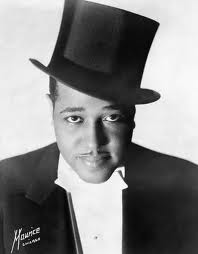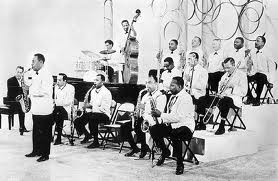Note from the Editor:
In response to popular request and a wave of vociferous public outrage, this will be the last Bumbastories Monday Magazine of the year 2014. No more Bumbastories Monday Magazines will be available – at least until next year.
(Thank goodness, says I. Too bad the year ends tomorrow)
✭✭✭✭✭✭✭✭✭✭✭✭✭✭✭✭
This week’s magazine features a song by Duke Ellington, a book review, an end-of-the-year-sort-of news update, a brief report from roving reporter George Packard, a very personal and heartfelt dissertation about ice cream, and then some more music.
Here’s a snappy version of Mood Indigo.
(Huh? How can Mood Indigo be snappy? How can Mood Indigo not be bluer than blue?)
https://soundcloud.com/songplayer/mood-indigo
Mood Indigo is a Duke Ellington standard of course. Written together with Barney Bigard and Irving Mills in 1930, it was played almost nightly, I believe, by Ellington and his orchestra for over forty years. Ellington’s band worked fifty weeks a year. They had two weeks off for vacation. It was a steady gig during hard times. Ellington kept the band going at times by using the money earned from his royalties. When asked how he managed to keep so many of the same musicians, many of them all-time greats of jazz, for so many years, Ellington answered that he had a secret. “I pay them,” he said.
☀☀☀☀☀☀☀☀☀☀☀☀☀
A BOOK REVIEW: LANGUAGE AND SPECIES by Derek Bickerton
 As noted in a previous blog, I chanced upon this fine book quite by chance, and have since wet my feet a bit in the icy and forbidding waters of Linguistics. I am aware that most bloggers (and that probably includes you) have less than minimal interest in linguistics. All the same, if you’d like to learn about the key subject in human psychology, or if you’re curious about the evolution of humans and human civilization, then language is something crucial to explore. Bickerton does just that. As I was saying he’s quite a guy. He goes straight for the interesting stuff. Linguistics can get very sticky and ticky-tack technical, but Bickerton’s logic and writing is excellent, and his approach always bold.
As noted in a previous blog, I chanced upon this fine book quite by chance, and have since wet my feet a bit in the icy and forbidding waters of Linguistics. I am aware that most bloggers (and that probably includes you) have less than minimal interest in linguistics. All the same, if you’d like to learn about the key subject in human psychology, or if you’re curious about the evolution of humans and human civilization, then language is something crucial to explore. Bickerton does just that. As I was saying he’s quite a guy. He goes straight for the interesting stuff. Linguistics can get very sticky and ticky-tack technical, but Bickerton’s logic and writing is excellent, and his approach always bold.
Drawing from his work exploring Creole and Pidgin languages, Bickerton speculates how language arose in our homo erectus hunter/scavenger ancesters. His logic is clear and incisive throughout, even though the terminology and lingo of linguistics is often a bit dense and hard to follow for the beginner.
Noam Chomsky, “father of modern linguistics, who recommends this book highly as well, asks in New Horizons in the study of language: “How do the genes determine the initial state (this innate language acquisition readiness), and what are the brain mechanisms involved?” Bickerson takes up this inquiry in Language and Species, steering us to consider a connection or link that was suddenly forged (in the brain somewhere) between homo erectus‘ capacity to communicate vocally and a “secondary representational system” which already included simple logic and syntax. Thus thought and language became intertwined.
It’s a knotty subject, it’s true.
✮✮✮✮✮✮✮✮✮✮✮✮✮
NEWS UPDATE 2014
It’s the end of 2014 and it seems everyone around town is still pessimistic and down in the mouth regarding the state of government today. And not just around town! Pessimism and cynicism about the future of the planet is rampant. If you think about government globally, well, the majority of governments round the world are autocratic. Our beacons of light, the proud democracies of the world, are becoming increasingly oligarchic and corrupt, controlled by a dominant ruling class – that 1% of the 1% that seems to have the politicians in their pockets and the game sewn up. We see existential crises at every corner which need to be addressed by these already-corrupted and barely functioning governments. Confidence ratings for politicians reflect this pessimism. Unfortunately it’s more than ordinary corruption. Everyone I talk to is shaking his head and muttering. Perhaps it’s because they’re all listening to their iphones. Ah, but don’t lose face, bunkie. Dig in and fight ’em.
We’re starting a new year. Happy New Year!
✰✰✰✰✰✰✰✰✰✰✰✰✰✰✰✰✰✰✰✰
MUSIC SECTION
Two American folk songs to sing along with. Or if you like, with which to sing along. Take your pick.
There’s John Henry and Footprints in the Snow. Two great songs that each tells a wonderful story. I look at John Henry as a political song, an affirmation of the right to be your own man, resist the machine to your very last. Footprints, a “written” song of uncertain authorship, (Reportedly, Bill Monroe claimed to have written it by himself, but the real songwriter was apparently somebody else) tells a lovely love story. Lyrics below. The songs come from different American folk music traditions, if I may be didactic: the Black, and the Country/Bluegrass, which of course merge and interplay a lot, and today are represented in rock and roll. I think everybody of all traditions can sing and enjoy these songs, this “roots” music.
(Please sing along)
John Henry


Footprints in the Snow
Now some folks like the summertime when the they can walk about
Strolling through the meadow green it’s pleasant there’s no doubt
But give me the wintertime when the snow is on the ground
For I found her when the snow on the ground
I traced her little footprints in the snow
I found her little footprints in the snow
I bless that happy day when Nellie lost her way
For I found her when the snow was on the ground
I dropped in to see her there was a big round moon
Her mother said she just stepped out but would be returning soon
I found her little footprints and I traced them in the snow
I found her when the snow was on the ground
Now she’s up in heaven she’s with the angel band
I know I’m going to meet her in that promised land
But every time the snow falls it brings back memories
For I found her when the snow was on the ground
✮✮✮✮✮✮✮✮✮✮✮✮✮✮✮✮✮✮✮✮✮✮✮
GEORGE PACKARD AND HIS SCOOP
When we last heard from roving reporter George Packard he was shifting gears in his search for a Breaking News scoop. George was settling for a scoop of ice cream, even for soft-serve!
Which leads us to the Magazine’s final story about ice cream:
✰✰✰✰✰✰✰✰✰✰✰✰✰✰
ICE SCREAM! YOU SCREAM!
I make no claim to be a connoiseur of ice-cream. On the other hand, when it  comes to ice-cream I am no slouch. Actually, sometimes I do slouch when I eat ice-cream on the sofa….. of an afternoon, watching the ballgame. Usually it’s Breyers for me. It’s “all natural” and a favorite from my childhood in the Bronx. Breyers had real tiny bits of vanilla beans in their vanilla. Back in the golden borough, we would get Breyer’s ice cream cones at the candy store – of which there were many back in the day.
comes to ice-cream I am no slouch. Actually, sometimes I do slouch when I eat ice-cream on the sofa….. of an afternoon, watching the ballgame. Usually it’s Breyers for me. It’s “all natural” and a favorite from my childhood in the Bronx. Breyers had real tiny bits of vanilla beans in their vanilla. Back in the golden borough, we would get Breyer’s ice cream cones at the candy store – of which there were many back in the day.
Speaking of the Bronx, we must turn our attention to Haagan Daaz ice cream. Wonderful Haagen-Dazs. It should come as no revelation that this gourmet ice cream is not made in Denmark, rather in the south Bronx. Hail to the Bronx! And hail to Haagen-Dazs! It’s great ice cream. However, for years, I, like everyone else, would see their Little Mermaid and drawing of Denmark on the cover of the carton and believe I was eating (and paying for) imported Danish ice cream. But no. The Mattus family in the Bronx simply thought that Haagen-Dazs was a good name (and gimmick). Say what you like, Haagen-Dazs is top-notch.
One of my current favorites is Foster’s Freeze Ice-Milk soft serve. I always get the chocolate cone. Not dipped! I’m a straight-up guy, and quite principled when it comes to important matters such as ice-cream. Yes, Foster’s, a California tradition since 1946 (but it appears to be a faded franchise and on its way out), still makes a good, plain custard. I remember fondly the custard ice-cream we would get as a special treat when we went out to City Island in the Bronx on those hot summer nights. It was the best.
Back in the old days, if you wanted regular, hard, hand-scooped ice-cream there was the neighborhood candy store. And then there was Howard Johnson’s – 26 flavors! and its pioneering chain of restaurants and motels nationwide, which is now mostly disappeared. Also in the Bronx we had Carvel, famous for their soft-serve, (Hail hail the Carvel Flying Saucer ice cream sandwich!). Later on they also sold hard ice cream, which was pretty good too. We must here take note that the whole ice cream world was revolutionized by the emergence of the Baskin-Robbins chain, who deserve an honorable mention in any serious discussion of ice cream.
As I said, when it comes to ice cream I am no slouch. On a personal level I continue to learn and to grow. There’s frozen yogurt (I like YogurtLand very much). There’s gelato! So many worlds to explore when it comes to ice cream!
✰✰✰✰✰✰✰✰✰✰✰✰✰✰✰✰✰✰✰✰

 Yesterday at a little group gathering, I was asked what my favorite song was. Immediately I replied “Mood Indigo”.
Yesterday at a little group gathering, I was asked what my favorite song was. Immediately I replied “Mood Indigo”.





